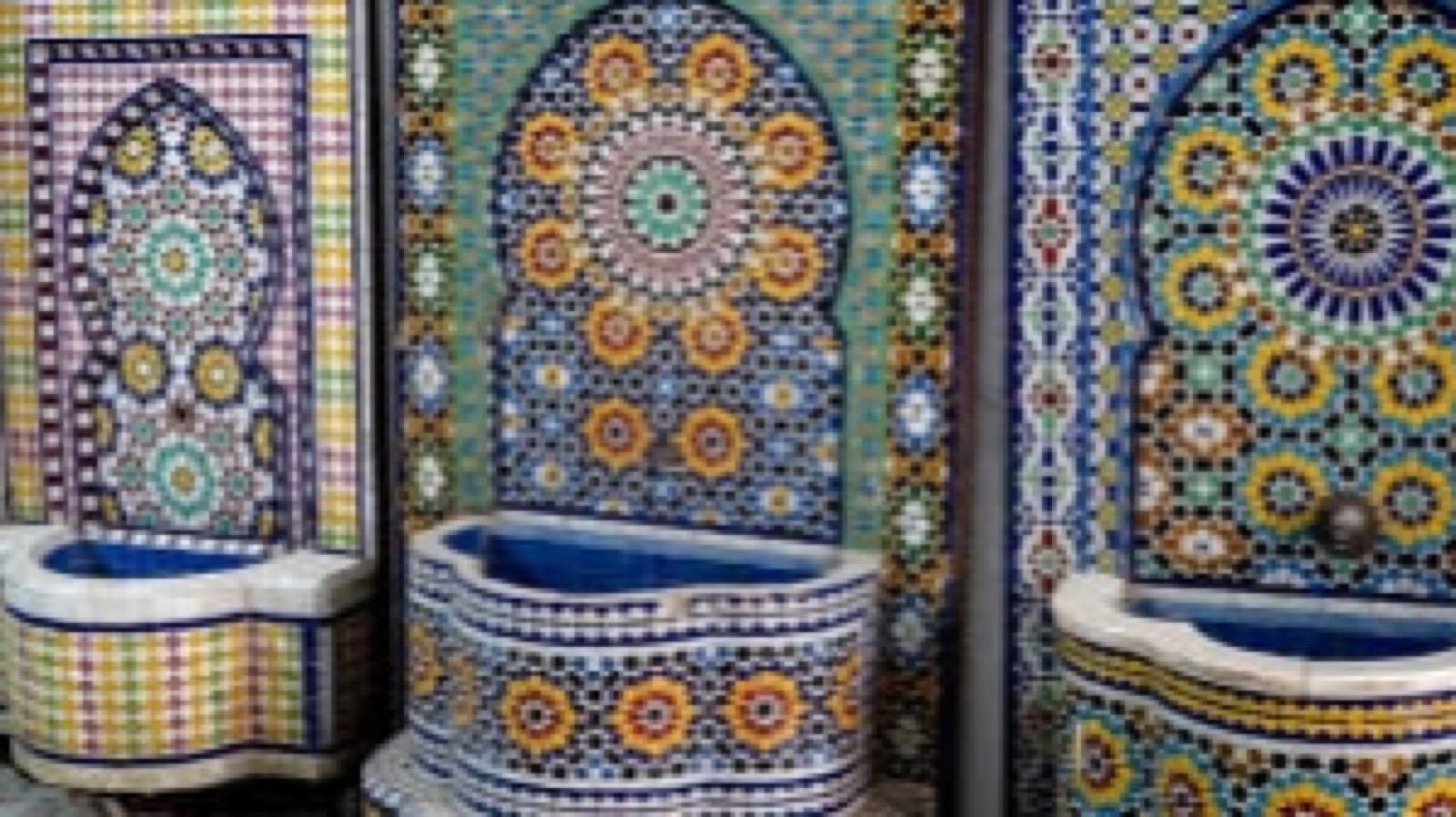
Moroccan Zellij is a stunning expression of geometric art and craftsmanship that has adorned Moroccan architecture for centuries. This intricate form of tilework, made from individually chiseled pieces of enamel-coated terracotta, is known for its complex patterns and vibrant colors. Found in mosques, palaces, fountains, and riads, Zellij is both functional and decorative, embodying a deep connection to Islamic art and Moroccan heritage. The mesmerizing designs are more than mere decoration—they represent harmony, precision, and the unity of the universe, making Zellij a spiritual and aesthetic treasure of Morocco.
Rooted in centuries-old traditions, Zellij has evolved into a symbol of Moroccan identity and artistic excellence. From the grand courtyards of the Al-Qarawiyyin Mosque in Fez to the serene courtyards of Marrakech riads, Zellij continues to captivate onlookers with its intricate beauty. Each piece is carefully hand-cut and placed by skilled artisans, preserving techniques that have been passed down through generations. As modern architecture looks for ways to incorporate cultural authenticity and artistic depth, Moroccan Zellij stands as a timeless source of inspiration and pride.
Historical Origins of Zellij
The art of Zellij dates back to the 10th century, with its roots in Moorish Andalusia and earlier Islamic art forms. It flourished during the Marinid dynasty, which ruled Morocco from the 13th to the 15th centuries, a period known for architectural and artistic achievements. Inspired by the Islamic emphasis on aniconic decoration, artisans developed geometric and floral motifs to express beauty and spirituality without depicting living beings.
This artistic movement found a perfect canvas in Moroccan architecture, where Zellij became an essential element in religious and royal structures. Over time, it was refined into a highly specialized craft that symbolized both artistic and mathematical mastery. The traditions established during this period continue to influence modern Zellij work, maintaining a strong link to its historical and spiritual origins.
Techniques and Craftsmanship
Creating Moroccan Zellij is a meticulous process that begins with crafting terracotta tiles, which are then glazed in vivid colors like cobalt blue, emerald green, saffron yellow, and burgundy red. Once glazed and fired, each tile is carefully hand-chiseled into precise shapes—stars, polygons, crosses, and more. These shapes are then assembled into elaborate mosaic patterns called “Tazra,” without the aid of printed guides.
Master artisans, known as "Maallems," spend years mastering the geometry and precision required for this craft. Their work involves not only artistic talent but also mathematical skills, as the interlocking patterns must be perfectly calculated to fit together seamlessly. The final compositions are often so complex that they resemble optical illusions, creating depth and movement with nothing more than color and form.
Symbolism and Meaning in Patterns
Zellij is not just visually captivating—it is also rich in symbolism. The geometric patterns often represent infinite growth and the divine order of the universe. Repeating motifs like stars and rosettes symbolize unity, balance, and the interconnectedness of all things. This symbolism is deeply rooted in Islamic philosophy, where geometry serves as a reflection of the Creator's perfection.
In Moroccan culture, these motifs are more than decorative—they are meditative and meaningful. Walking through a courtyard or praying in a mosque adorned with Zellij offers an immersive experience that connects the viewer to a deeper spiritual and cultural consciousness. Each piece of Zellij is part of a larger narrative, one that blends mathematical logic with mystical beauty.
Zellij in Moroccan Architecture
Zellij is an integral part of Moroccan architecture, seen in the walls, floors, fountains, and columns of traditional buildings. In mosques, it is used to embellish mihrabs and qiblas, while in palaces, it forms decorative bands around courtyards and salons. Its water-resistant quality also makes it ideal for hammams and public fountains, combining functionality with elegance.
The Royal Palaces of Fez and Meknes, the Saadian Tombs in Marrakech, and the Hassan II Mosque in Casablanca are some of the most iconic examples of Zellij in architecture. In these structures, Zellij doesn’t merely serve as ornamentation—it plays a role in shaping the experience of space, creating a visual rhythm that draws the eye and soothes the soul.
Colors and Regional Variations
While certain colors dominate traditional Zellij—such as blue, green, white, and yellow—each region of Morocco has developed its own signature palette. Fez, the historical capital of Zellij, is known for its classic blue and white combinations, while Marrakech often features warmer tones like ochre and burgundy, reflecting the city’s desert surroundings.
These regional differences extend to design styles as well. In Tetouan and Chefchaouen, you might find simpler, more rustic patterns, while in cities like Rabat and Casablanca, contemporary interpretations with bolder color contrasts are emerging. This diversity allows Zellij to maintain a sense of continuity while embracing local identity and innovation.
Zellij in Modern Design
Today, Moroccan Zellij is experiencing a renaissance, not only within Morocco but across the globe. Designers and architects are incorporating Zellij into modern homes, boutique hotels, and cultural institutions to bring texture, color, and authenticity to contemporary spaces. Whether as a kitchen backsplash, a mosaic tabletop, or a decorative wall panel, Zellij adds character and history to modern interiors.
Moroccan artisans are also collaborating with global designers to adapt traditional Zellij techniques to new formats and materials, including ceramics, glass, and even digital prints. This fusion of old and new keeps the craft alive, ensuring that future generations can appreciate the beauty and intricacy of Zellij while adapting it to their own creative visions.